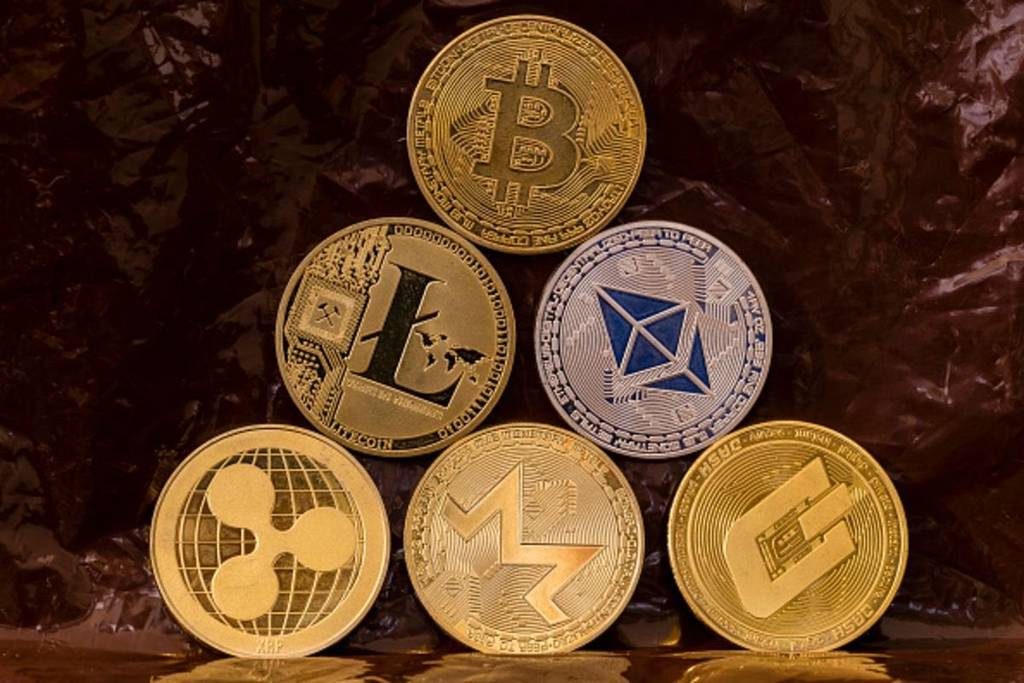Cryptocurrency, Welcome to the Dark Side


- Cryptocurrency comes with risks
- Unstable prices
- Crypto wallets
- Centralization
- ICO scams
- Crypto controversies
- Successful hackings
- Regulations for the crypto industry
- Final words
Cryptocurrencies have become a hot topic in the modern financial world. And by the looks of it, they’ll most likely remain as such for years. Therefore, few can blame you if you thought this game-changing technology was flawless. If you ever had a conversation with crypto enthusiasts, they would likely try to convince you that it is.
However, while cryptocurrencies are a groundbreaking concept, they come with their fair share of dangers.
To explain to you why you must always be careful when dealing with cryptocurrencies, I will cover some of these problems. So the next time you engage in crypto trading, keep in mind the risks you could face.
Content Overview
- Cryptocurrency hazards
- Crypto controversies
- Major breaches and hacks
- Cryptocurrency regulations
- Conclusion
The Dangers of Cryptocurrency
Investing in cryptocurrency became a big hit a few years ago when crypto prices started growing.
Bitcoin (BTC), the first and largest cryptocurrency in the world, reached an all-time high (ATH) of $20,000 per coin back in late 2017. This hike sparked an increase in all crypto prices as well, which encouraged people to join the hype and invest in these digital currencies.
But, as you might have gathered so far, investing and trading in crypto can be quite risky. There are so many dangers surrounding this relatively new concept, which is why it’s better to start by learning the basics of cryptocurrency.
Furthermore, you should know what you’re getting yourself into, so here are some of the hazards that you should keep in mind.
Price Instability
The first thing to note is that cryptocurrencies are extremely volatile, especially Bitcoin. Not just because it is unstable, but also because the rise and fall of its price are very extreme. I’m not talking about some mere cents here, but more like hundreds, and even thousands of dollars.
Just look at its performance in the last two years. It reached a peak of $20,000 in December 2017; then it dropped to $6,300 by mid-2018. It then suffered another slump to $3,200 by January of this year.
In May 2019, it climbed back to $8,000 and extended its rise to $14,000 in June. But it once again dropped to $9,000, only to jump to its current $11,800 price.
So as you can see, it’s one heck of a rollercoaster ride.
Imagine that you bought BTC when it was at $20,000, only to see it lose 80% of its value. That is the danger you are facing at any time, as Bitcoin’s price can change depending on the events in the world.
When a major company decides to adopt it, investors see it as a good sign, and they start buying rapidly, which causes the price to grow due to demand. But if the US government, for example, chooses to ban it, its price will undoubtedly crash within a few hours.
This is a consequence of volatility, as no real-world asset backs Bitcoin. Its value will always depend on the demand of investors.


Security Risks
The second hazard is more of a technical matter, and it revolves around how you store your coins. Typically, coin holders keep their currencies in cryptocurrency wallets.
There are several different kinds of wallets, such as hot (online), cold (offline, in the form of a USB stick-like device), paper, desktop, and such.
With each wallet, you get a public and a private key. The public key is your wallet’s address, which is the one you share with other parties so that they can send you coins.
The private key, however, is for your eyes only, and it is the only thing that proves you are the owner of the wallet. You use it for ‘signing’ (confirming) transactions. If someone gets their hands on it, they’ll be able to break into your wallet and steal your funds.
There is also a danger of losing access to your wallet if you forget your password, which would also result in losing your funds forever.
Online wallets are easy to use as they are always accessible online, but they are also often the target of hackers. Offline wallets, on the other hand, are safer since they are not connected to the internet at all times. But, there’s always a chance they could get stolen or lost.
The bottom line is that both wallets have their advantages and disadvantages. Therefore, it is up to you to secure your fund. That is the price you have to pay for being in charge instead of the banks.
Centralized Wallets
A lot of people keep their funds in a centralized crypto exchange’s wallet, which is a big mistake if you ask me.
Cryptos are decentralized, meaning that no one controls them but the person who owns the coins. So it makes no sense to deposit your coins into a centralized exchange, as you would give the service full control of your funds.
If something happens to the exchange while it holds your coins — a hacking attack, a crash of its servers, a sudden shutdown — your funds will be out of your reach, potentially forever. Hackers often attack these services, which I will discuss in detail below.
In Canada, the founder of a major crypto exchange, Quadriga, unexpectedly passed away on a business trip. He was the only one who had access to the wallets and funds. Therefore, with his death, all the funds were locked away, with no hope of anyone ever breaking into the exchange’s crypto vault and retrieving them.
Scams
Scams are one of the biggest dangers in the crypto industry, and a reason why the ICO (Initial Coin Offering) token sale model nearly went extinct in 2018.
ICOs are a way for crypto developers to deliver their coins to the public and raise money for the continuation of their project.
They would use a minimal amount of money to fund the creation of their cryptocurrency. Then, they present their project’s concept to the public and start offering their coins. If the public finds that the crypto has a bright future, they will invest, which increases its value and price. Investors would then sell their coins for a much higher price and make a profit.
Back when the crypto prices were soaring in 2017, ICOs were extremely popular. New coins hit the market almost daily, with people happy to invest as prices increased. This encouraged scammers to introduce some fake coins and sell them in ICOs.
The number of scams skyrocketed, and millions of dollars were stolen from naive investors who thought they were making easy money. It was not long before the regulators took notice, and realized that the investors are not safe, leading to an entire ICO crackdown.
“… we found that approximately 78% of ICO’s were Identified Scams, ~4% Failed, ~3% had Gone Dead, and ~15% went on to trade on an exchange.”
Satis Group
They shut down fake ICOs, along with some legitimate ones, because they were selling securities instead of utilities. While cryptocurrencies have no regulations in most parts of the world, securities do. And since these actions did not comply with security regulations, it led to hefty fines and penalties.
Soon after, ICOs stopped emerging, and people ceased investing. No one wanted to put money in securities and have trouble with the law.
Cryptocurrency Controversies
Apart from dangers, the cryptocurrency world is full of controversies.
One of those concerns Tether (USDT), a top-ten cryptocurrency that’s considered as ‘stablecoin.’ In other words, it can minimize volatility and maintain a stable price.
Tether claimed that each of its coins is worth exactly $1 and that its value will never change. That’s because the same amount of USD backs every one of its coins. To put it simply, if the currency has 4 billion coins in circulation, the company behind it must own $4 billion in its bank account.
The system itself makes sense, although it is not exactly decentralized. As a result, many started questioning whether stablecoins are even real cryptocurrencies.
However, the real problem is that the company refuses to provide an audit of its reserves to prove if it can back Tether. As a result, many investors assumed that it doesn’t have enough funds to cover the coins, which resulted in a massive oversale of Tether in 2018.
But the crypto somehow managed to survive the controversy and remain among the top 10 coins, despite the emergence of other legitimate stablecoins.
Regulations, Anonymity, and Security
Other controversies include the fact that cryptocurrencies don’t have regulations in most countries. This means that regulators can, at any given time, ban them or impose hefty taxes on those who own them.
Furthermore, cryptocurrencies allegedly provide anonymity, which is not the case anymore. After the rise of these digital currencies and their popularity among cybercriminals, governments started regulating the crypto sector.
They claim that they needed to do so to combat terrorism, money laundering, and other crimes. But their primary reason is to control the unregulated money that circulates the crypto world.
As for security, cryptos supposedly have immunity against cyberthreats. However, several hacks took place over the years, and millions of dollars worth of cryptocurrency were stolen.
But I should point out that the attacks targeted exchanges, not cryptos. The latter uses blockchain technology, which is practically impossible to breach. Hackers would have to gain control of the thousands of servers that form the chain and make changes on all of them.
Bitcoin Creator Controversy
There’s also the controversy surrounding the creator of Bitcoin; Satoshi Nakamoto, which is, of course, the pseudonym of the person or persons behind this crypto.
Several people came out to claim that they are Mr. Nakamoto, one of whom was Craig Wright. However, most people believe that this is just a hoax as Wright could never prove it. Even John McAfee, the founder of software company McAfee Associates, said that he knows the real identity of Nakamoto, but that his lawyers advised him not to reveal it.
He did, however, ensure that it wasn’t Craig Wright.
Cryptocurrency Major Breaches
Several infamous cryptocurrency hacks took place over the past few years, especially after cryptos ‘went big.’
The first significant crypto hack was so big and shocking that it is still a topic of discussion today. It happened five years ago, in 2014. 850,000 BTC were stolen from a leading Japanese crypto exchange called Mt. Gox, and the company had to close because of it.
It managed to retrieve around 200,000 BTC, but the investors’ confidence was shattered, and the exchange soon filed for bankruptcy. Many believed that this would be the end of Bitcoin, too, but it certainly wasn’t.
However, this was not the most significant attack on a crypto exchange. That ‘honor’ goes to Coincheck, and it happened a year and a half ago, on January 26th, 2018.
The Japan-based exchange published a blog post announcing that it will restrict deposits and withdrawals of NEM token. At first, it did not give any explanation behind this bizarre move. But after several post updates, the exchange revealed that it was hacked and that around 500 million NEM tokens were taken.
At the time, the value of these coins amounted to $530 million, which impacted the crypto sector in a major way. In fact, some credit this hack as one of the causes of the crypto winter.
Coincheck soon had to shut down as well, but it recently relaunched its services and is operating under Japan’s FSA license.
BitGrail Controversy
A few weeks later, another big exchange service made headlines as 17 million NANO tokens were stolen from BitGrail. This amounted to $195 million at the time. But this hack had something fishy about it as experts couldn’t tell whether the exchange suffered an actual attack, or if it was a scam all along.
Whatever the case may be, the exchange soon filed for bankruptcy, and the owner was sentenced to return the stolen funds.
Binance Hack
The latest big hack hit the world’s largest crypto exchange, Binance. It happened only a few months ago, on May 7th, 2019, and it resulted in around 7,070 BTC ($40.7 million) stolen.
This attack wasn’t as significant as the others, and Binance had more than enough money to deal with the consequences. However, the very fact that hackers managed to infiltrate the world’s biggest exchange shook the crypto world.
But despite the attack, Binance did not suffer any significant damages. The exchange continued its routine operations smoothly, and its Binance Coin (BNB) was not affected by what happened.
It compensated affected users for their loss from its Secure Asset Fund. And while Binance saw a 7% decrease in its daily transaction volume, things quickly went back to normal.
Cryptocurrency Regulations Around the World


One of the biggest problems in the cryptocurrency industry is the lack of regulations. Digital currencies have been around for over ten years, that much is true. However, the regulators did not take them seriously for years. They believed it to be just a passing trend; something that would never go global.
After all, how could some digital funds with no real value or backing ever become a threat to the dominant global financial systems?
But after the crypto wave swept the world in 2017, regulators were not laughing at the idea anymore. Some countries saw potential in cryptocurrencies, with Japan and South Korea being among the first to accept them.
The regulations are still far from perfect as the crypto industry continues to evolve. Many believe it to be in its early stages, even after ten years of evolution and development. If that is true, nobody can tell what it might become someday.
However, a lot of countries are at least trying to regulate them.
France is about to bring its own set of rules and guidelines, which would likely make it the European crypto hub. Moreover, Japan, Malta, and South Korea are among the countries with the friendliest environment in the world for cryptos.
“France is a precursor. We will have a legal, tax, and regulatory framework.”
Anne Marechal, Executive Director for Legal Affairs at France’s FMA
Meanwhile, several other nations are exploring cryptocurrencies, learning more about it, and attempting to create a proper regulatory framework. Even Russia is trying to do it, with its regulators following direct orders from President Vladimir Putin.
The US Crypto Industry
In the US, however, the situation is quite different.
Regulators do not seem to be doing much concerning that matter, and the situation remains extremely unclear. Cryptocurrencies might get regulations or bans; it could go either way. This uncertainty had some negative ramifications for the US crypto industry, as all those entrepreneurs decided to leave the country and start their businesses elsewhere.
The US, with its seemingly limitless resources, had the chance to set an example for the entire world. It failed to do so, and it is now losing its advantage. Many are turning to eastern countries for ideas and guidance.
Conclusion
As you can see, there’s still a lot of vagueness surrounding the crypto industry. From regulations to dangers and controversies, getting involved in this sector is quite risky. Even if you take every precautionary measure, you could still end up losing a lot.
But a lot of people are willing to take that chance because they see that cryptocurrencies have a lot of potentials. Therefore, investing in them can be their ticket to riches and wealth. Others genuinely believe in these digital currencies and consider them the way of the future.
But regardless of the category, you should learn all that you can about the crypto world and its hazards. That way, you’ll be able to make smart and profitable investments. And even if things go haywire, you won’t suffer any damaging losses. After all, no one can predict the prices of Bitcoin, Ethereum, Ripple, and the rest of the cryptocurrencies.
Have you ever invested in cryptocurrency? Did you come out on the winning or losing side? Share your story with us in the comment section below.




I agree, it is quite volatile but can you name anything that generated similar returns in the last 2 years?